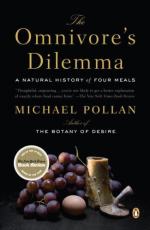
|
| Name: _________________________ | Period: ___________________ |
This test consists of 15 multiple choice questions and 5 short answer questions.
Multiple Choice Questions
1. Pollan points out that the industrial method of farming has led to increased ________ and polluted groundwater.
(a) Energy.
(b) Oil wells.
(c) Food supplies.
(d) Pollution.
2. At the beginning of the food chain is ________, which surprised Pollan when he realized this.
(a) Corn.
(b) Cows.
(c) Sugar.
(d) Flour.
3. Pollan looks over the land and it makes him think of _________, which is something marketers now try to sell.
(a) Postcard.
(b) Ancient.
(c) Family.
(d) Pastoral.
4. Wallerstein originally worked for a _______ where he learned he could entice people to buy more with larger sizes.
(a) Restaurant.
(b) Library.
(c) University.
(d) Movie theater.
5. Humans are not a perfect natural system in the food system because they can only _______ so much food.
(a) Consume.
(b) Throw away.
(c) Make.
(d) Buy.
6. Hybrid corn is a __________ hog, according to this chapter, and is able to be grown without disruption of fertility issues.
(a) Bean.
(b) Soil.
(c) Fertilizer.
(d) Water.
7. The factories from the war time began to produce ________ for farmers to help with their crops.
(a) Organic blends.
(b) Fertilizers.
(c) Wheat.
(d) GMOs.
8. The idea behind grass farming is that the ________ is the most natural and renewable source of energy.
(a) Worker.
(b) Water.
(c) Land.
(d) Sun.
9. Pollan points out during the book that omnivores face a __________ when they eat today.
(a) Truth.
(b) Overabundance.
(c) Dilemma.
(d) Problem.
10. How many acres of woodland help Salatin continue to live outside the modern world?
(a) 450.
(b) 250.
(c) 100.
(d) 5.
11. Where is the farm that George Naylor runs when Pollan goes to visit him to learn more?
(a) Iowa.
(b) Nebraska.
(c) Kansas.
(d) Ohio.
12. In what part of the body can one determine just how much corn is being eaten by the person?
(a) Flesh.
(b) Nails.
(c) Hair.
(d) Teeth.
13. In a bad corn year, the food industry might use __________ as a replacement in many foods.
(a) Baking soda.
(b) Salt.
(c) Soybeans.
(d) Wheat.
14. In many CAFOs, the _______ of pigs are cut off in response to the aggressive behavior they have in those conditions.
(a) Ears.
(b) Noses.
(c) Tails.
(d) Legs.
15. What is the name of the once trash strewn park that was turned into a community garden?
(a) Berkeley Park.
(b) Roller Park.
(c) People's Park.
(d) Garden Park.
Short Answer Questions
1. Salatin is a strong believer in farming in line with one's ___________, as seen in a phone call with Pollan.
2. Who introduced the idea of using corn to the English settlers?
3. Where do all of the parts of the corn end up in as a result of the new process to separate its parts?
4. Pollan learns that most organic _______ comes from factory farms, even though they seem to be "better."
5. Salatin's ______ invented many of the methods of farming that are used on the farm today.
|
This section contains 434 words (approx. 2 pages at 300 words per page) |

|




